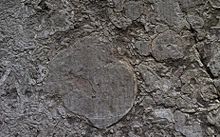Bluestone (natural stone)




Bluestone is a trade name for different rocks . The most famous bluestones include:
- Right Blaustein - a slate from the Unterordovicium with ages from 488.3 to 478.6 million years ago,
- Aachener Blaustein - a limestone from the Middle to Upper Devonian with an age of 392 to 374.5 million years and the Lower Carboniferous with an age of 359.2 to 328.3 million years.
Demarcation
Since the quarries near Aachen are exhausted, no more high-quality material can be produced there. Belgian granite is usually used as a substitute , which is often referred to as "petit granite", the characteristic feature of which is the massive occurrence of crinoids . The stone is still mined in Belgium near Soignies ( Hainaut Province ) and Tournai ( Ourthe Valley). Belgian granite is also a limestone and not an igneous rock like granite .
The English word "bluestone" refers to a dolerite rock, from which some stone blocks from Stonehenge are also made.
Right bluestone
Right Blaustein came out of the place right at Sankt Vith in Ostbelgien 50 ° 19 '20 "N, 6 ° 3' 26" O . The bluish slate was extracted there first in surface mining and from 1880 in underground mining. Before the First World War , the mine was closed for economic reasons. Since May 18, 2007 it has been open again as a visitor mine.
Aachen bluestone
Aachener Blaustein is the trade name for a dark gray to black limestone from different geological systems, which was quarried on the northern edge of the High Fens in the southeast of Aachen , in the current nature reserve Schomet ( 50 ° 43 ′ 27 ″ N, 6 ° 13 ′ 17 ″ E ). The name probably comes from Flemish stonemasons who came to Aachen after the city fire in the 17th century and introduced the name Blaw Stejn here . Hermann von Weinsberg (1518–1597), councilor in Cologne, already described tombstones made of bluestone in his memoirs ( Das Buch Weinsberg. From the life of a Cologne councilor ) .
The rocks of the Lower Walheim mass limestone from the Givetium , the Upper Walheim mass limestone from the Frasnium and the frasnium tuber limestone belong to the bluestone varieties used in the Devonian. The lower, middle and upper coal lime was processed as bluestone from the lower carbon . Characteristic feature of the Aachener blue stones is the appearance of numerous fossils such as bryozoans (bryozoans) goniatites , Hydrozoa , coral and stromatoporoids . The stone has just been cut and is polished to an almost black, blue-gray to blue-green color. This changes to white-gray when exposed to weathering for a long time .
Bluestone was used as a stone for window frames, door sills, stairs, floor coverings, tombs and church furnishings such as altars and baptismal fonts. Many baroque buildings in Aachen and the surrounding area as well as the base of the Gothic choir hall of Aachen Cathedral are made of bluestone. The medieval canal for the Pau was also made of this material.
Web links
Individual evidence
- ↑ Belgian granite. Natural stone Riedner, archived from the original on October 4, 2009 ; accessed on March 14, 2014 .
- ↑ Slate gallery right . , accessed March 14, 2014
- ↑ a b Aachen bluestone . Natural stone and tile processing Waldeck, accessed on March 14, 2014
- ↑ Karl-Heinz Ribbert: Geology in the Rhenish Slate Mountains - Part 1 North Eifel , Geological Service NRW, Krefeld, 2010 pp. 36–43, 116
